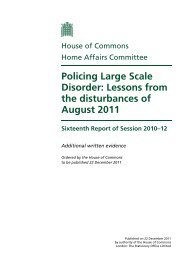Vulnerability and involvement in drug use and ... - Sex Work Europe
Vulnerability and involvement in drug use and ... - Sex Work Europe
Vulnerability and involvement in drug use and ... - Sex Work Europe
You also want an ePaper? Increase the reach of your titles
YUMPU automatically turns print PDFs into web optimized ePapers that Google loves.
2 Method<br />
Sampl<strong>in</strong>g<br />
The sample was selected to provide participants with experience of both <strong>drug</strong> <strong>use</strong> <strong>and</strong> sex<br />
work <strong>and</strong> to provide quotas on age <strong>and</strong> exit<strong>in</strong>g experience. This was pr<strong>in</strong>cipally a study of<br />
an unknown population, <strong>and</strong> as such was dependent on a convenience sample. Sub-<br />
sample quotas of particular sex or ethnic groups were not sought nor predicted. In the end,<br />
the sample did <strong>in</strong>clude both men <strong>and</strong> women from a variety of ethnic groups. However, as<br />
t h e re were no re s e a rch questions on sex, gender or ethnicity, f<strong>in</strong>d<strong>in</strong>gs are not presented on<br />
these variables.<br />
Recruitment<br />
A range of re c ruit<strong>in</strong>g strategies was employed. The majority of participants were<br />
re c ruited through voluntary <strong>and</strong> statutory agencies provid<strong>in</strong>g a service to sex workers<br />
(n=87; 70%). One participant was re c ruited via a service for <strong>drug</strong> <strong>use</strong>rs. Eleven<br />
p a rticipants were re c ruited from other statutory <strong>and</strong> voluntary services. Fifteen<br />
p a rticipants were re c ruited via sex worker advertis<strong>in</strong>g space on the web <strong>and</strong> <strong>in</strong> a<br />
contact magaz<strong>in</strong>e. The rema<strong>in</strong><strong>in</strong>g eleven participants were <strong>in</strong>troduced to the study by<br />
cha<strong>in</strong> re f e rral to participants’ associates <strong>in</strong> a ‘snowball sampl<strong>in</strong>g’ technique (Mars,<br />
1982; Plant, 1975). A majority of participants (n=87; 70%) were re c ruited fro m<br />
London. Others were re c ruited from Birm i n g h a m / Walsall <strong>and</strong> the Home Counties (n=27;<br />
22% <strong>and</strong> n=11; 8%, re s p e c t i v e l y ) .<br />
Prospective participants were typically approached by an agency worker <strong>and</strong> <strong>in</strong>troduced to<br />
the re s e a rc h e r. When prospective participants met the re s e a rcher face-to-face, they were<br />
asked to read an <strong>in</strong>formation sheet detail<strong>in</strong>g the study aims, procedures <strong>and</strong> confidentiality<br />
conditions (see Appendix B). If an <strong>in</strong>dividual had difficulties read<strong>in</strong>g the <strong>in</strong>formation sheet,<br />
or if contact was made by telephone, this <strong>in</strong>formation was delivered verbally. Prospective<br />
participants were <strong>in</strong>vited to ask questions about any aspect of the study prior to consent<strong>in</strong>g<br />
to participate. All participants were asked to register their underst<strong>and</strong><strong>in</strong>g <strong>and</strong> consent to<br />
p a rticipate <strong>in</strong> the study by sign<strong>in</strong>g a consent form (see Appendix C). In the <strong>in</strong>terests of<br />
assur<strong>in</strong>g confidentiality, participants were <strong>in</strong>formed that they did not need to sign the form<br />
us<strong>in</strong>g their full name.<br />
17
















